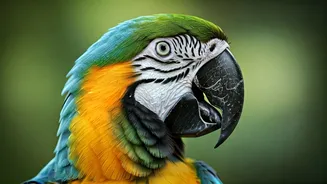Smart As Can Be
Parrots, contrary to popular belief, are incredibly intelligent beings. They possess cognitive abilities comparable to those of a young child. They can
solve puzzles, learn through observation, and even understand cause and effect. Numerous studies have demonstrated their remarkable capacity for problem-solving. Some parrots exhibit complex communication skills, utilizing various vocalizations and body language to convey their thoughts and feelings. Moreover, their intelligence extends beyond simple mimicry. They can categorize objects, recognize faces, and adapt their behavior to different situations. This level of intelligence sets them apart in the avian world and highlights their remarkable mental capabilities. Their ability to adapt and learn is truly impressive.
Chatty Companions
The ability of parrots to mimic human speech is one of their most well-known and fascinating traits. They can accurately reproduce words, phrases, and even entire conversations. This mimicry isn't merely about rote repetition; parrots often use the words in context, demonstrating a degree of understanding. They learn through listening and observation, and their vocal range is incredibly diverse. Some parrots can build extensive vocabularies, enabling them to communicate with humans in surprisingly meaningful ways. Their linguistic skills are a testament to their intelligence and capacity for learning. They are capable of adopting tones and accents, adding another layer to their communicative abilities. This is why parrots can become such beloved and engaging companions.
Social Butterflies
Parrots are highly social creatures, thriving on interaction and companionship. In the wild, they live in flocks, forming close bonds with their fellow birds. Within these social groups, they engage in various behaviors such as preening, sharing food, and defending each other from danger. These behaviors strengthen social cohesion and contribute to their overall well-being. Keeping a parrot as a pet requires similar attention to their social needs. They need regular interaction and stimulation to prevent boredom and loneliness. A lonely parrot can develop behavioral problems. The social lives of parrots are a key aspect of their identity, influencing everything from their communication to their emotional health. Their dependence on social interaction reflects their deep-seated need for connection and belonging.
Feathery Variety
The parrot family is a diverse group, encompassing hundreds of different species. These birds come in a dazzling array of sizes, colors, and shapes. From the tiny budgerigar to the massive Hyacinth macaw, each species has unique characteristics. Their plumage is often vibrant, showcasing an array of colors. Their beaks and feet also vary, adapted to their specific lifestyles and dietary needs. The diversity of parrot species is a testament to their adaptability and their ability to thrive in various environments. Understanding the variety within the parrot family is critical for appreciating the uniqueness of each species. This rich diversity continues to captivate bird enthusiasts and researchers alike.
Long-lived Legends
One of the most remarkable features of parrots is their longevity. Many species can live for several decades, and some can even outlive their human companions. Factors like good nutrition, a stimulating environment, and attentive care contribute to their long lifespans. The average lifespan for a parrot varies depending on the species. Proper care includes a balanced diet, regular veterinary check-ups, and plenty of mental stimulation. Their extended lifespans emphasize the significant commitment required when owning a parrot. Their longevity allows them to bond deeply with their owners, offering companionship for many years. Many parrot species are living proof of resilience and adaptability.
Strong Beaks Needed
Parrots have powerful beaks that are uniquely designed for a variety of tasks. Their beaks are not just for eating; they are essential tools used for climbing, manipulating objects, and defense. The strong, curved beak allows them to crack nuts, peel fruits, and even climb trees with ease. The beak's structure is also ideal for grooming, allowing parrots to maintain their feathers effectively. Because the beak is so important, it's essential to provide parrots with toys and objects that encourage healthy use and wear. Without proper use, their beaks can become overgrown. Understanding the role of a parrot's beak is key to understanding its overall lifestyle and wellbeing.
Amazing Aerialists
Parrots are exceptional fliers, using their wings to navigate their environment with grace and precision. Their flight abilities are essential for escaping predators, searching for food, and finding mates. Some species are capable of incredible feats of aerial acrobatics. Parrots have evolved with specialized feathers and skeletal structures, enhancing their ability to fly. Their wing shapes, for example, vary depending on the species and the type of flight they require. The speed, maneuverability, and gracefulness of parrots in flight are a sight to behold. This natural skill is crucial for their survival and contributes to their overall freedom and independence in the wild. This characteristic makes them unique among many bird species.
Conservation Matters
Many parrot species face threats in the wild. Habitat loss, hunting, and the pet trade have put numerous species at risk. Conservation efforts are now underway to protect parrots and their habitats. These conservation initiatives include habitat preservation, anti-poaching measures, and community education. Efforts to conserve parrots are vital to ensure that these incredible birds continue to thrive in the world. Supporting conservation organizations and promoting responsible pet ownership are crucial steps in protecting these beautiful creatures. By understanding the challenges they face, and contributing to the conservation efforts, we can make a difference.



